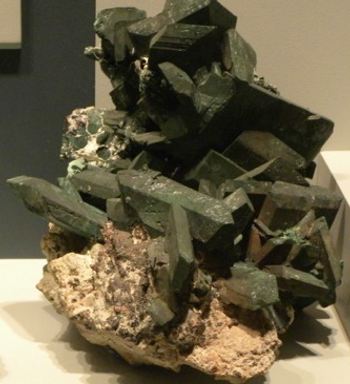working to make science better For the 118 indvidual WIS elements, GO to MORE in the menu above . . .




Copper 29
Where is copper used--or where does it impact our everyday lives?
Used for electrical wiring because of its cost, availability and electrical conductivity.
Copper symbol: Cu
Atomic number: 29 Atomic Mass: 64
Transition Metal
Group 11 Period number: 4
Melting point: 1084.62 °C, (1984.32 °F)
Boiling point: 2562 °C, (4643 °F)
Reaction with air (oxidizes) 2Cu + O2 --> 2CuO
Reaction with water: No Reaction
Electron configuration: 2, 8, 18, 1
Source: LANL.gov
Researcher: Luke C
The photograph on the left shows a sixth grade Patriot fan in the Maker Space with librarian Ms. M making a copper tape circuit.
Photographer: Ms. M

Above a sample of native copper from the New Cornelia mine, Ajo, Arizona, USA on display at the National Museum of Natural History, Washington DC viewed during a Chemistry One field trip.
WIS Photographer

Copper is deposited at the cathode (negative electrode) during the electrolysis of copper sulfate solution. See a video of this process.
Copper is mixed with zinc to make the alloy brass--and alloyed with tin to make bronze
Copper is used in water pipes in houses.



A common copper mineral is malachite CuCO3 from the Democratic Republic of Congo viewed at the National Museum of Natural History, Washington DC during a Chemistry ONE field trip
WIS Photographer

Another sample of malachite, CuCO3(OH)2, (after azurite) from Tsumeb, Namibia, viewed at the National Museum of Natural History, Washington DC during a Chemistry ONE field trip
WIS Photographer

Aurichalcite with hemimorphite (CuZn)5(CO3)2(OH)6 from Yankee mine, Juab County, Utah, USA
viewed at the National Museum of Natural History, Washington DC during a Chemistry ONE field trip
WIS Photographer

Devillite CaCu4(SO4)2(OH)6,3H2O from Spana Dolina, Slovensko, Slovakia viewed at the National Museum of Natural History, Washington DC during a Chemistry ONE field trip
WIS Photographer

Copper is present in the mineral tetrahedrite twinned with chalcopyrite (FeCu)12Sb4S9 from Clausthal, Niedersachsen, Germany viewed at the National Museum of Natural History, Washington DC during a Chemistry ONE field trip
WIS Photographer

Copper is used as flashing on the roofs of the Carriage House and the Mansion at Tregaron at the Washington International School in Washington DC, USA. Here a decorative finial on the roof of the Carriage House is made of copper and the surface has oxidized firstly to copper oxide, CuO, and then with carbon dioxide, CO2, to green copper carbonate, CuCO3.

The l.e.d. lights glow when the sample of copper completes the circuit demonstrating that copper is conducting low-voltage electricity.
WIS Photographer

Some of the results obtained during an IB Chemistry Exrended Essay series of experiments--investigating the rings formed when one needle electrode and a copper plate electode are electrolysed (current passed) with different concentration of ethanoate solutions Eleventh grader, Olivier M's experiment.
WIS Photographer
